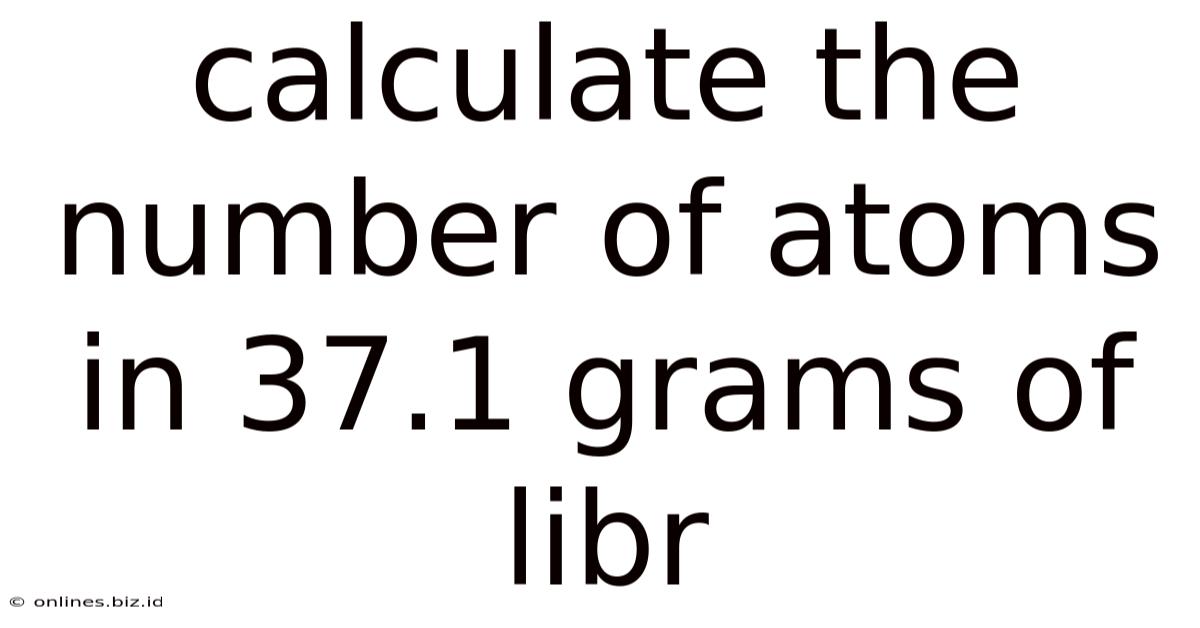Calculate The Number Of Atoms In 37.1 Grams Of Libr
Onlines
May 12, 2025 · 4 min read

Table of Contents
Calculating the Number of Atoms in 37.1 grams of LiBr
Determining the number of atoms in a given mass of a compound requires a fundamental understanding of chemistry, specifically molar mass, Avogadro's number, and stoichiometry. This article will guide you through the step-by-step process of calculating the number of atoms in 37.1 grams of lithium bromide (LiBr), explaining the concepts involved and providing a detailed solution. We will also explore some related concepts and considerations.
Understanding the Fundamentals
Before diving into the calculation, let's review the key concepts:
1. Molar Mass
The molar mass of a substance is the mass of one mole of that substance, expressed in grams per mole (g/mol). A mole is a fundamental unit in chemistry representing Avogadro's number (approximately 6.022 x 10²³) of entities (atoms, molecules, ions, etc.). To find the molar mass of LiBr, we need to add the atomic masses of lithium (Li) and bromine (Br) from the periodic table.
- Atomic mass of Li: Approximately 6.94 g/mol
- Atomic mass of Br: Approximately 79.90 g/mol
Therefore, the molar mass of LiBr is 6.94 g/mol + 79.90 g/mol = 86.84 g/mol.
2. Avogadro's Number
Avogadro's number (N<sub>A</sub>) is a crucial constant in chemistry, approximately equal to 6.022 x 10²³. It represents the number of entities (atoms, molecules, ions) in one mole of a substance. This number provides the link between the macroscopic world (grams) and the microscopic world (atoms).
3. Stoichiometry
Stoichiometry is the quantitative relationship between reactants and products in a chemical reaction. In this case, we're not dealing with a reaction, but the principle of stoichiometry still applies when relating the number of moles of a compound to the number of atoms within it. One mole of LiBr contains one mole of lithium ions (Li⁺) and one mole of bromide ions (Br⁻).
Calculating the Number of Atoms
Now, let's calculate the number of atoms in 37.1 grams of LiBr:
Step 1: Convert grams to moles
We'll use the molar mass of LiBr to convert the given mass (37.1 grams) to moles:
Moles of LiBr = (Mass of LiBr) / (Molar mass of LiBr) = 37.1 g / 86.84 g/mol ≈ 0.427 moles
Step 2: Determine the number of formula units
Since one mole of LiBr contains Avogadro's number of formula units (LiBr), we can find the number of formula units in 0.427 moles:
Number of LiBr formula units = (Moles of LiBr) x (Avogadro's number) = 0.427 mol x 6.022 x 10²³ formula units/mol ≈ 2.57 x 10²³ formula units
Step 3: Calculate the total number of atoms
Each formula unit of LiBr contains two atoms (one lithium atom and one bromine atom). Therefore, the total number of atoms is:
Total number of atoms = (Number of LiBr formula units) x (Number of atoms per formula unit) = 2.57 x 10²³ formula units x 2 atoms/formula unit ≈ 5.14 x 10²³ atoms
Therefore, there are approximately 5.14 x 10²³ atoms in 37.1 grams of LiBr.
Further Considerations and Related Concepts
Significant Figures
It's crucial to pay attention to significant figures throughout the calculation. The given mass (37.1 g) has three significant figures, and the molar mass (86.84 g/mol) has four. The final answer should be reported to three significant figures, as dictated by the least precise measurement.
Isotopes
The atomic masses used in the calculation are average atomic masses, considering the natural abundance of different isotopes of lithium and bromine. If the isotopic composition deviates significantly from the natural abundance, the molar mass and hence the final answer will also change.
Ionic vs. Covalent Compounds
LiBr is an ionic compound, meaning it exists as a lattice of Li⁺ and Br⁻ ions rather than discrete molecules. The term "formula unit" is used instead of "molecule" to represent the smallest electrically neutral unit of the compound.
Applications
Understanding how to perform these calculations is fundamental in many areas of chemistry, including:
- Analytical Chemistry: Determining the concentration of solutions and the composition of samples.
- Stoichiometric Calculations: Predicting the amounts of reactants and products in chemical reactions.
- Materials Science: Characterizing the properties of materials based on their atomic composition.
Conclusion
Calculating the number of atoms in a given mass of a compound involves a straightforward yet powerful application of fundamental chemical concepts. By understanding molar mass, Avogadro's number, and stoichiometry, we can accurately determine the number of atoms in a sample, providing insights into the microscopic world from macroscopic measurements. This article provided a detailed, step-by-step solution for calculating the number of atoms in 37.1 grams of LiBr, highlighting the importance of precision and consideration of significant figures and isotopic variations. Mastering these concepts is essential for success in various fields of chemistry and related scientific disciplines.
Latest Posts
Related Post
Thank you for visiting our website which covers about Calculate The Number Of Atoms In 37.1 Grams Of Libr . We hope the information provided has been useful to you. Feel free to contact us if you have any questions or need further assistance. See you next time and don't miss to bookmark.